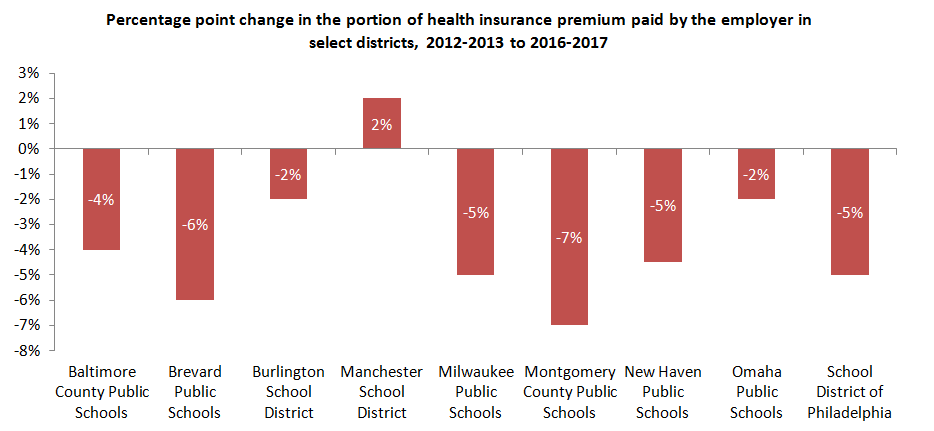District Trendline, previously known as Teacher Trendline, provides actionable research to improve district personnel policies that will strengthen the teacher workforce. Want evidence-based guidance on policies and practices that will enhance your ability to recruit, develop, and retain great teachers delivered right to your inbox each month? Subscribe here.
One key component of teacher compensation is health insurance. It gets less attention than salaries and pensions, but as the costs of health care rise, this issue will become increasingly visible. This month, District Trendline uses data from the Teacher Contract Database to examine how much of the health insurance premium is covered by school districts and how this has changed over the last four years.
Coverage of health insurance premiums
We are able to calculate the percent of the health insurance premium that districts cover for 75 of the 124 largest districts in our regular sample. Of these 75 districts, 40 districts (53 percent) cover the entire health insurance premium. That helps to explain how the average share of the premium paid by the employer is 93 percent. According to data from the Bureau of Labor Statistics, the share is significantly more generous than the average share covered by employers in private industry (79 percent) and slightly more generous than the average coverage by state and local government employers (87 percent).

With only one exception, districts contribute the same amount to every teacher’s plan regardless of their tenure in the district. Prince George’s County Public Schools (MD)is the only district in the sample thatcovers different portions of health insurance premiums depending on a teacher’s years of experience: 75 percent for the first eight years of employment and 80 percent thereafter.
Health insurance premium coverage over time
From 2006 to 2016, the average annual health insurance premium increased by 58 percent with more of the burden falling to workers rather than employers. Worker contributions increased by 78 percent over that same time period, according to data from the Kaiser Family Foundation. As health insurance premiums get more expensive, are school districts decreasing their share of the premium cost?
While we don’t have data from 2006, we do have data on health insurance premium coverage going back to the 2012-2013 school year for 37 districts. The majority of those districts, 28, cover the same portion of teachers’ health insurance premiums in 2016-2017 as they did back in 2012-2013. The portion of the premium covered by the district decreased in 8 districts, ranging from a two percentage points decrease in Omaha Public Schools and Burlington School District (VT) to a seven percentage point decrease in Montgomery County Public Schools (MD).

Manchester School District (NH) was the only district that saw an increase in the portion of a teacher’s health insurance premium it covered over the five-year period, with the district’s portion of the premium covered increasing from 85.5 percent in 2012-2013 to 87.5 percent in 2016-2017. The district’s contract, however, states that the maximum portion covered will be reduced to 85 percent in 2017-2018, half a percentage point lower than in 2012-2013.
It’s worth noting that the Teacher Contract Database only tracks the portion of the premium covered by the district so we are unable to take into account changes in the quality of the health insurance offered. Some districts may choose to address an increase in the cost of health insurance by reducing the portion of the premium they fund, while others may reduce the cost of the premium by switching to a more affordable plan.
Health incentives
It is not uncommon for districts to offer incentives or penalties to encourage their employees to maintain a healthy lifestyle. For example, some plans have monthly surcharges for smokers while others offer additional money towards or rebates on the premium for completing health assessments or staying up-to-date on preventative screenings.
The state of Kentucky pays the full premium for non-smokers, but only 95 percent of the premium for smokers. Montgomery County Public Schools (MD) requires smokers to pay an additional three percent of their premium, while also offering to pay an additional two percent more of the premium for any employee who completes a health risk assessment and blood work.
Conclusion
The majority of large school districts are generous when it comes to health care benefits they provide to teachers. While it’s true that more districts are reducing the portion of the health insurance premium they cover for teachers than are increasing their share, the vast majority of districts in our sample continue to invest at a consistent level in their teachers’ health benefits.
Interested in learning more? Access all of our data, including information on health care premiums for dependents, here.
The Teacher Contract Database includes information on 147 school districts and 2 charter management organizations in the United States including: the 100 largest districts in the country, the largest district in each state, and the member districts of the Council of Great City Schools. The database features answers to over 100 policy questions and provides access to teacher contracts, salary schedules, and board policies in addition to relevant state laws governing teachers.
More like this

Does paid parental leave for teachers pay off?

The data and analyses district leaders used to support their work in 2024

Myth-busted: Teachers don’t skip school

